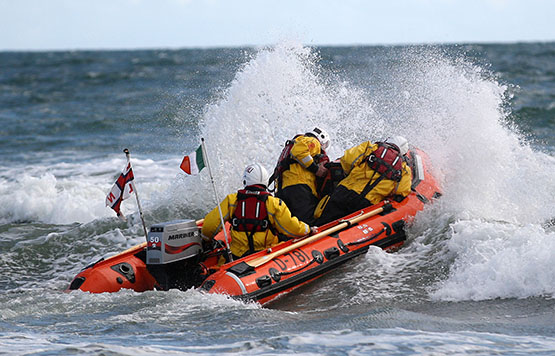Tramore RNLI officially named their new D-class lifeboat Isabella Purchase during a ceremony at the National Lifeguard Training Centre in Tramore on Saturday. The honour of naming the new lifeboat went to Mrs Sally Mongey, wife of the late Finn Mongey. Finn was the Lifeboat Operations Manager for Tramore RNLI Lifeboat Station from when it re-opened in 1964 until his retirement in 1984.
The lifeboat was named in honour of Mrs. Ivy Purchase, who was known as Isabella, and who died in September 2012, leaving her estate to the Royal National Lifeboat Institution (RNLI) to provide a lifeboat in her name. She lived in Midhurst, West Sussex and was a long-time supporter of the charity. The new lifeboat, which has already launched four times on service since its arrival, replaces the Trá Mhór lifeboat, which was placed on service on 30 June 2005 and launched 127 times, rescuing 100 people, over its lifetime.
Tramore RNLI was the first Irish lifeboat station to receive the original of the D-class lifeboats in 1964. They were specially developed by the RNLI for inshore rescues carried out close to land and hard to access areas.
The D-class lifeboat is built at a cost of €62,000 and has been the workhouse of the charity for nearly 50 years. It is inflatable, robust and highly manoeuvrable, capable of operating much closer to the shore than the all-weather lifeboats. It is especially suited to surf, shallow water and confined locations, often close to cliffs, among rocks or caves. It measures five-metres in length and can carry three crewmembers on board. It has an endurance of three hours at sea, at its maximum speed of 25 knots.
Peter Crowley of the RNLI Irish Council accepted the lifeboat on behalf of the Institution before handing her over into the care of Tramore Lifeboat Station. Speaking during the handover he said,
‘As marine leisure activity around our coast increases, the demand for our rescue services grows in tandem with this increased activity. In Tramore the station’s lifeboat crew have rescued a total of 54 people in the last five years. One can only imagine the life changing impact of these rescues on both the casualties and the volunteer crew members who performed them. I thank you for your invaluable contribution and I am in awe of your selflessness and dedication.’
Mrs. Sally Mongey, wife of former Tramore RNLI Lifeboat Operations Manager Finn Mongey officially names the station’s new D-class lifeboat ‘Isabella Purchase’ assisted by the station’s current Lifeboat Operations Manager Derek Musgrave
‘Every naming ceremony for a new lifeboat is a special occasion and today we are honouring Mrs. Isabella Purchase and her generous life-saving gift to the Institution and the people of Tramore.
‘We couldn’t operate our lifeboat without the dedication of our volunteers. The crew in Tramore provide an outstanding service to their community. There is nothing greater that a person could offer and they deserve nothing less than the best in lifeboats, equipment and training that the RNLI offers. May our lifeboat crew come home safely in the Isabella Purchase and may they bring many home to safety.’
Among the platform party at the service were Mr. Len Bell, Chairman of Tramore Lifeboat Station who welcomed guests and opened proceedings; Peter Crowley, RNLI Irish Council member who accepted the lifeboat on behalf of the RNLI and handed her into the care of the station; Derek Musgrave, Tramore RNLI Lifeboat Operations Manager, who accepted the lifeboat on behalf of the station; Frank Nolan, President of the Tramore Lifeboat Station, who proposed the Vote of Thanks and Mrs Sally Mongey, who officially named the lifeboat.
Fr. Shane O’Neill and The Very Reverend Maria Janssen lead the Service of Dedication and music was provided by the Doirdan Male Choral Ensemble, Mr. Damien Kehoe, Mrs Claire Musgrave and Mrs. Cecelia Kehoe.
In a special moment during the ceremony three of Tramore RNLI’s volunteer lifeboat crew received their Long Service Badges and Certificates for 20 years’ service to the life-saving charity. They were Raymond Cowman, Brian Kavanagh and Stephen Murray.
Tramore RNLI has a proud and distinguished record in the RNLI, receiving 13 Silver Medals for Gallantry and the Thanks of the Institution Inscribed on Vellum on five separate occasions. The lifeboat station was opened in 1824 with the first lifeboat rowed by a crew of eight lifeboat men. The station closed in 1924 but was reopened again in 1964 with a D-class lifeboat; this class of lifeboat has been on service since then with improvements made to successive lifeboats.































































